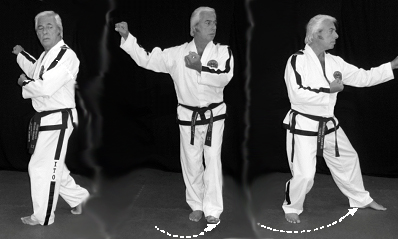
Countless notes have been written and much has been theorized about the unique biomechanics designed by General Choi Hong Hi. There is usually great emphasis placed on hand positioning and postures to be assumed in the execution of the patterns he designed. In most cases, such emphasis on detail often results in performers executing movements in a stiffness way and lacking naturalness, thus without practical application of the movements they so meticulously developed.
Among the many factors typically conveyed in a seminar, there is always an omission considered minor detail: precisely returning to the starting point in the execution of the patterns. I have previously written about this omission, even in competitions. Judges are trained to observe and deduct from the overall score awarded to each competitor the deficiencies they detect in the execution of the pattern they choose and the one assigned to them. However, they are not trained to apply deductions for competitors who do not return precisely to their starting point.
Is this a minor detail and thus disregarded? Clearly, it is treated as such, but no, it is not a minor detail. A significant percentage of technical corrections made in foot and hand positions, correct facing, use of angles, and rotations are intimately linked to this seemingly minor detail. Have you tried to adhere to this detail? If you did it, you have likely discouragingly noticed how often you have to recognize your shortcomings. To my surprise some high-ranking black belts often ask me if all patterns begin and end in the same place or only some applies to this rule. When I confirm that all patterns indeed start and finish in the exact same place, it prompts them to review their practices, often without achieving satisfactory results.
I can still hear General Choi’s voice insisting on this matter and his emphatic «almost» when this was not fulfilled. If you stand on positions that do not meet the established parameters, your balance will be precarious, and the power in your hands will inevitably be diminished. This means that the strength and effectiveness of your hands largely depend on your feet. Do you feel unstable when rotating? Unless you have consumed alcohol before performing the pattern, some aspect of your feet positioning is likely not correctly executed for this to happen, especially after having performed that rotation many times.
When everybody tears their clothes proclaiming left and right that they teach General Choi Hong Hi’s Taekwon-Do and then walk in a different way than the one established by him, I wonder how they are going to develop and teach his Taekwon-Do if they walk differently than proposed.
When you teach a beginner to move sideways, do you teach them on which part of the foot should rotate, or do you let them do it as they see fit? In Saju Jirugui and Saju Maki, you must teach this detail, which includes learning and incorporating vertical and horizontal sinusoidal motion. If they learn it there, they will have learned it for all other patterns. If you overlook this important step in your teaching, you leave the development of the student’s movements, rotations, and stability to chance. If you want to be effective with your hands, review the use of your feet.
SGM Ricardo Desimone
To be aware read again the previous notes
